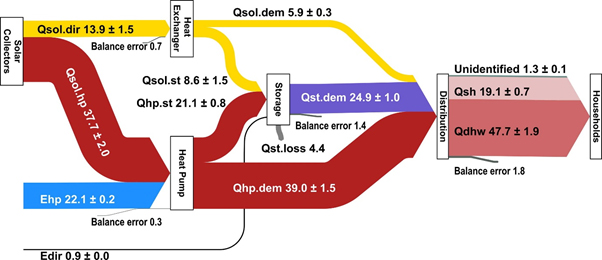Solar Energy journal / Best Paper Award

Sankey diagram of the solar assisted heat pump system, year 2012 (units: kWh/m2)
We are happy to announce that the following UNIGE paper was selected as the Best Paper published in the Solar Energy journal in the last two years in the category Solar Heating and Cooling, Buildings and Other:
Fraga C., Hollmuller P., Mermoud F., Lachal B. (2017). Solar assisted heat pump system for multifamily buildings: Towards a seasonal performance factor of 5? Numerical sensitivity analysis based on a monitored case study. Solar Energy, 146, pp. 543-564
The award is given to papers published in the ISES scientific journal "Solar Energy", that demonstrate significant pioneering contributions to the solar energy literature, for innovative concepts or approaches, and whose quality and presentation have a lasting impact.
Abstract
The present work analyses the potential of a combined solar thermal and heat pump (HP) system on new and existing multifamily buildings. The study uses numerical simulation as a complement to a monitored case study. After a description of the case study and a summary of the monitoring results, we present the numerical model developed for this study. Simulation results are validated with the monitored values, at component and system level, in terms of monthly profiles and yearly integrals. On this basis, we carry out an extensive sensitivity analysis concerning the principal sizing parameters of the system. Finally, we investigate the sensitivity of the system to space heating (SH) and domestic hot water (DHW) demands, in particular concerning the applicability of the analysed system in the case of building retrofit. For Geneva’s weather conditions, a sizing factor of 3 m2 solar collector per kW of HP capacity is a good compromise between system size and system performance, resulting in a system seasonal performance factor (SPFsys) between 3.1 and 4.1, depending on the SH distribution temperature. The associated electricity consumption (ranging from 12 kWh/m2 for a new low-energy building, up to 45 kWh/m2 for a non-retrofitted building) strongly depends on the heat demand. Such is also the case for the collector area (from 0.08 m2 per m2 heated area for a new low-energy building, up to 0.20 for a non-retrofitted building). Finally, a SPFsys of 5 could potentially be achieved, but only in newly constructed buildings with a high efficient envelope, a low SH distribution temperature, and with a collector area of at least 0.20 - 0.25 m2 per m2 heated area. However, the related investment may not be worthwhile, given the rather small associated electricity saving, not to mention that such a collector area would not fit on buildings with more than 4 storeys.
Links
Full paper: https://archive-ouverte.unige.ch/unige:93432
PhD thesis: https://archive-ouverte.unige.ch/unige:94939
Resumé (FR): http://www.expert-ise.ch/pompes-chaleur-sur-le-residentiel-collectif-quelle-source-pour-quelle-demande
19 Oct 2019